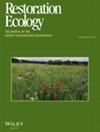Governance and policy constraints of natural forest regeneration in the Brazilian Amazon
IF 2.7
3区 环境科学与生态学
Q2 ECOLOGY
引用次数: 0
Abstract
Environmental legislation requires well‐defined concepts, criteria, and indicators to support its effective implementation and provide legal security to the diverse stakeholders involved. The Native Vegetation Protection Law (NVPL) establishes the obligation to restore native vegetation in protected areas within rural properties. This federal law is regulated and implemented by each state through its own Environmental Compliance Program (Programa de Regularização Ambiental [PRA], in Portuguese). Landowners must register their land, indicate whether native vegetation needs to be restored (i.e. if there is an environmental debt), and submit a restoration plan to the state government for analysis, validation, and approval. Due to the high cost of forest restoration, natural regeneration has most likely become a viable strategy for Amazonian landowners to meet their environmental debts. However, according to disturbance intensity, frequency, and duration, natural regeneration will not always succeed. In this context, we analyzed the PRAs of the seven main Amazonian states to assess the status of their implementation, identify how natural regeneration is defined and approached in the law, and evaluate whether improvements in the law are needed to ensure effective restoration to accomplish the NVPL.巴西亚马逊天然林再生的治理和政策制约因素
环境立法需要定义明确的概念、标准和指标,以支持其有效实施,并为不同的利益相关者提供法律保障。原生植被保护法》(NVPL)规定了在农村财产保护区内恢复原生植被的义务。各州通过各自的环境合规计划(Programa de Regularização Ambiental [PRA],葡萄牙语)来管理和实施这项联邦法律。土地所有者必须对其土地进行登记,说明是否需要恢复原生植被(即是否存在环境债务),并向州政府提交恢复计划,以供分析、验证和批准。由于森林恢复成本高昂,自然再生很可能成为亚马逊土地所有者偿还环境债务的可行策略。然而,根据干扰强度、频率和持续时间,自然再生并不总是成功的。在此背景下,我们分析了亚马逊七个主要州的 PRAs,以评估其实施状况,确定法律中如何定义和处理自然再生,并评估是否需要改进法律以确保有效恢复,从而实现 NVPL。
本文章由计算机程序翻译,如有差异,请以英文原文为准。
求助全文
约1分钟内获得全文
求助全文
来源期刊

Restoration Ecology
环境科学-生态学
CiteScore
6.50
自引率
15.60%
发文量
226
审稿时长
12-24 weeks
期刊介绍:
Restoration Ecology fosters the exchange of ideas among the many disciplines involved with ecological restoration. Addressing global concerns and communicating them to the international research community and restoration practitioners, the journal is at the forefront of a vital new direction in science, ecology, and policy. Original papers describe experimental, observational, and theoretical studies on terrestrial, marine, and freshwater systems, and are considered without taxonomic bias. Contributions span the natural sciences, including ecological and biological aspects, as well as the restoration of soil, air and water when set in an ecological context; and the social sciences, including cultural, philosophical, political, educational, economic and historical aspects. Edited by a distinguished panel, the journal continues to be a major conduit for researchers to publish their findings in the fight to not only halt ecological damage, but also to ultimately reverse it.
 求助内容:
求助内容: 应助结果提醒方式:
应助结果提醒方式:


